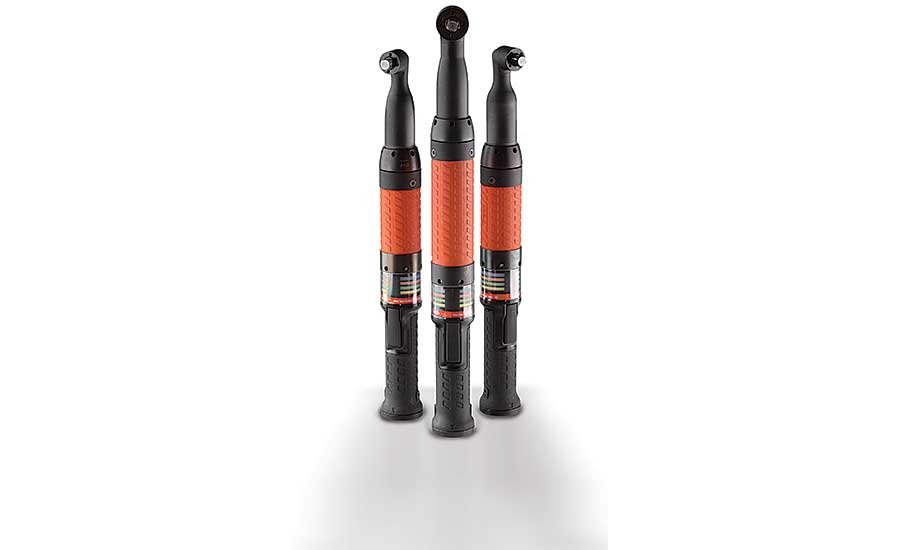Sometimes, when a product has been around for many years, the best way to gain market share in a crowded field is to completely rethink the design.
This is exactly what Cleco Production Tools opted to do some five years ago when it came time to revamp its line of corded, DC electric nutrunners. Now, the results of that redesign effort are finally ready. In July, Cleco launched NeoTek, a new line of corded electric assembly tools designed to be more reliable, accurate and ergonomic than previous models. The tool, the controller, and even the cable connecting the two have been rethought.
“We designed these new tools to improve the operator’s experience and exceed industry standards,” says Adrian Hetzel, product manager at Cleco, a business unit of Apex Tool Group’s Power Tools Division. “The tool body is light and smooth with a handle designed to have multiple controls without being inconvenient to the operator.”
Ergonomics—particularly tool weight—was a key design parameter for the NeoTek tools, says William Cain, director of global engineering services at Apex Tool Group. In designing the new tool, Apex engineers embarked on what Cain calls a “voice of the customer world tour,” gathering feedback from assemblers at factories across the country. Rapid prototyping enabled engineers to test tool handles and triggers of various shapes and sizes.
The end result is a tool that is 21 percent lighter than Cleco’s previous model.
Durability and reliability were also watchwords during the redesign. The right-angle head of the nutrunner is a machined component rather than a casting, and the drive system consists of spiral-cut bevel gears. As a result, the tool can run 1 million cycles maintenance-free—two or three times the industry standard.
“NeoTek will allow businesses to significantly increase their return on investment,” says Bob Heisner, global vice president of marketing for the Power Tools Division. “Solutions that improve productivity and decrease system and maintenance costs are in high demand.”
The new tool is also accurate. The tool’s capability, as measured by Cm and Cmk indexes, is 2.0, ±7 percent.
Made of a soft-durometer material, the handle of the tool provides visual, audible and tactile feedback on the fastening operation. Four LED light rings—red, yellow, green and blue—are configurable and easily visible.
“Our previous tool had small LEDs, which were not always easy to see depending on the orientation of the tool,” says Cain. “The new LEDs are easily visible, and you can adjust their intensity.”
The handle has a configurable, two-position, start switch rated for 4 million cycles. The handle also has configurable, multifunction buttons that can be used to trigger various operations, such as scrolling through menus on the controller or operating a bar code scanner.
The tool can be equipped with numerous accessories. For example, an integrated bar code scanner boosts productivity by eliminating the need to set the tool down and pick up a separate device. A gyroscope can provide feedback to the operator for applications in which the tool must be kept level during fastening. Other accessories include a two-hand start switch, work light and location module (for error-proofing and guided fastening applications).
The centerpiece of the system is the Cleco mPro400GC-Hybrid Controller, which features a large touchscreen with an easy-to-use software interface. Programming can be done directly from the unit or remotely from a PC using license-free software.
The dual-analog and digital controller supports legacy models of Cleco corded electric tools (17, 47, 67, 18 and 48 Series), as well as the company’s LiveWire cordless tools. One controller can accommodate up to 16 corded or cordless tools.
The controller supports industry-standard protocols and fieldbus communication, which allows for easy integration into any manufacturing environment. The controller can work with accessories such as “smart” socket trays and stack lights.
The use of digital communication from tool to controller reduces the number of conductors in the electrical cable from 28 to eight, significantly decreasing the cable’s diameter and reducing its weight by 50 percent. Having fewer conductors also means the cord has a better bend radius for accessing hard-to-reach locations. An orange stripe running the length of the cable facilitates correct installation during festooning and helps maintenance technicians easily identify twisted cables.
The cable also features a quarter-turn twist-lock connector, an industry-first. The previous cable was equipped with screw-on connectors. Those provided a secure connection, but it was easy to damage the fine threads.
Two right-angle tools—the 30 and 50 series—and the Hybrid Controller are the first products to be introduced as part of a complete NeoTek portfolio that is set to launch over the next year.
Four models are available in the 30 series, which is designed for low-torque applications. The smallest has a torque range of 1.3 to 6 newton-meters; the largest has a torque range of 5.7 to 28 newton-meters. All the tools in the 30 series weigh less than 3 pounds.
Seven models are available in the 50 series, which is intended for medium-torque applications. The smallest has a torque range of 6 to 30 newton-meters; the largest has a torque range of 41 to 205 newton-meters. Tool weight ranges from 3.5 to 8.7 pounds.
“There is some torque overlap between some models. Which to choose depends on your torque and speed requirements,” says Michael Sandy, product specialist with Apex Tool Group.
For more information on NeoTek assembly tools, call 800-845-5629 or visit www.clecotools.com.



